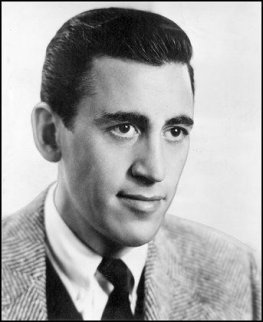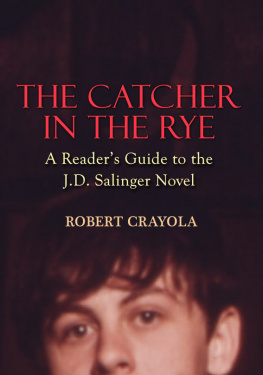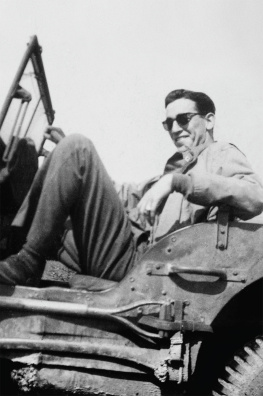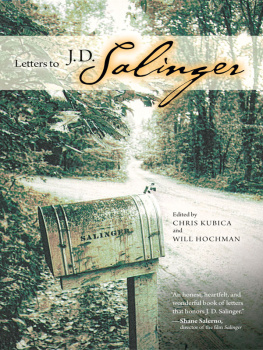J. D. SALINGER: THE LAST INTERVIEW
AND OTHER CONVERSATIONS
Copyright 2016 by Melville House Publishing
Introduction copyright 2016 by David Streitfeld
First Melville House printing: November 2016
The Compensations Are Few, But When They Come, If They Come, Theyre Very Beautiful. by William Maxwell 1951 by the Book-of-the-Month Club. First published in the Book-of-the-Month Club News on July 1951.
It Was a Great Relief Telling People by Shirlie Blaney 1953 by The Claremont Daily Eagle. First published in The Claremont Daily Eagle on November 13, 1953.
J. D. Salinger Speaks About His Silence by Lacey Fosburgh 1974 by Lacey Fosburgh. First published in The New York Times on November 3, 1974.
Ten Minutes with J. D. Salinger: How an English Teacher Survived Bad Roads, Protective Natives, Menacing Dogs and Shotgun Threats to Land an Exclusive Interview with the Legendary Hermit of Contemporary Lit I by Greg Herriges 1979 by Greg Herriges. First published in Oui Magazine in January 1979.
Afterword 2016 by Greg Herriges.
If Youre Lonely, as Most Writers Are, Write Your Way Out of It. by Michael Clarkson 1979 by Michael Clarkson. First published in the Niagara Falls Review on November 12, 1979. Afterword 2016 by Michael Clarkson.
A Frozen Moment in Time by Betty Eppes 1980 by the Baton Rouge Sunday Advocate. First published in the Baton Rouge Sunday Advocate on June 29, 1980.
Standing In for Salinger: Confessions of J.D.s One-Time Letter Writer by Joanna Smith Rakoff 2002 by Joanna Smith Rakoff. First published in Book Magazine in September/October 2002.
Betraying Salinger: I Scored the Publishing Coup of the Decade: His Final Book.
And Then I Blew It. by Roger Lathbury 2010 by Roger Lathbury.
First published in New York magazine on April 4, 2010.
Melville House Publishing
46 John Street
Brooklyn, NY 11201
and
8 Blackstock Mews
Islington
London N4 2BT
mhpbooks.com facebook.com/mhpbooks @melvillehouse
Library of Congress Cataloging-in-Publication Data
Names: Salinger, J. D. (Jerome David), 19192010. | Streitfeld, David, writer of introduction.
Title: J. D. Salinger : the last interview and other conversations / J. D. Salinger; introduction by David Streitfeld.
Description: Brooklyn : Melville House, [2016]
Identifiers: LCCN 2016038287 (print) | LCCN 2016038331 (ebook) | ISBN 9781612195896 (pbk.) | eBook ISBN: 9781612195902 (ebook)
Subjects: LCSH: Salinger, J. D. (Jerome David), 19192010Interviews. | Authors, American20th centuryInterviews.
Classification: LCC PS3537.A426 Z46 2016 (print) | LCC PS3537.A426 (ebook) | DDC 813/.54 [B] dc23
LC record available at https://lccn.loc.gov/2016038287
v3.1
CONTENTS
Interview by William Maxwell
Book-of-the-Month Club News
July 1951
Interview by Shirlie Blaney
The Claremont Daily Eagle
November 13, 1953
Interview by Lacey Fosburgh
The New York Times
November 3, 1974
How an English Teacher Survived Bad Roads, Protective Natives, Menacing Dogs and Shotgun Threats to Land an Exclusive Interview with the Legendary Hermit of Contemporary Lit I
Interview by Greg Herriges
Oui Magazine
January 1979
Interview by Michael Clarkson
Niagara Falls Review
November 12, 1979
Interview with Betty Eppes
Baton Rouge Sunday Advocate
June 29, 1980
Deposition of plaintiff JEROME D. SALINGER, taken by defendants, pursuant to notice, at the office of Messrs. Satterlee & Stephens, 230 Park Avenue, New York, N.Y., 10169, on Oct. 7, 1986, at 2:10 p.m., before Donna Rogers, a Shorthand Reporter and Notary Public of the State of New York.
Confessions of J.D.s One-Time Letter Writer
By Joanna Smith Rakoff
Book Magazine
September/October 2002
I Scored the Publishing Coup of the Decade:
His Final Book. And Then I Blew It.
By Roger Lathbury
New York Magazine
April 4, 2010
INTRODUCTION
DAVID STREITFELD
A writers worst enemy is another writer.
J. D. SALINGER , as quoted by his
brother-in-law Gavin,
according to Thomas Beller
in J. D. Salinger: The Escape Artist
J. D. Salinger was the Wizard of Oz of American letters. People journeyed for days to meet him, hoping he could cure whatever was ailing them. But Salingers powers were limited, just like the Wizards. He could do nothing for his fans they could not do for themselves. If you were a jerk when you ventured to his hilltop retreat in the New Hampshire village of Cornish, you were a jerk when you left town.
The legend of Salinger took root during the hopeful years of the early 1960s, when the American empire was at its zenith, progress and enlightenment were on the march, and Time magazine was both the celebrant and enforcer of the culture. One day, the Time editors set themselves a perplexing problem: What is the deal with this guy Salinger? Why does he resist the embrace of the media? What is wrong with him? It was high noon not only for the Great American Novel, that mythical beast, but also for the novelist as hero, sage, and savior, and Salinger wasnt doing his part. Time unleashed a vast fact-finding operationin essence, teams of private detectivesto uncover Salingers secrets without, the magazine assured readers, unduly compromising his privacy. Thats what they always say.
Times opus, A Private World of Love and Death, appeared in the September 15, 1961, issue, available everywhere for twenty-five cents. The tone is set in the first paragraph, just after the inevitable quote from The Catcher in the Rye about Holden wanting to build a cabin in the woods where he would pretend to be one of those deaf-mutes so I wouldnt have to have any goddam stupid useless conversations with anybody. The magazine then describes a hilltop house in the woods where the recluse lives. Not long ago, Time recounts, when he and his family were away, a couple of neighbors could stand it no longer, put on dungarees and climbed over the 6-ft. fence to take a look around.
Stop right there. What is the it that these neighbors could not stand, that drove presumably law-abiding folks to unlawful entry? Was it not knowing the details of a life they had no right to know? Was it Salingers crankiness, his disdain? Time does not say, but it proved a powerful force for at least forty years, motivating nosy neighbors, trashy as well as respectable reporters, devout fans, and the merely curious. The number who made the pilgrimage to the hilltop was easily in the hundreds if not thousands, and the reports they brought back of their success or, more often, failure helped set the pattern for modern tabloid culture, where the medias, and perhaps even the publics, eagerness to know is pitted against the celebritys right not to be known. Even if the eventual winner was never in doubt, if Salinger was reduced to posting signs that demanded, or maybe begged, No hunting, trapping, fishing, or trespassing of ANY kind, the battle, at least for a time, was surprisingly well matched.











